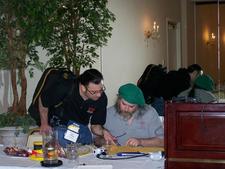USENIX Tips for Admins: Virtualization and HPC Don't Go Together
At the USENIX LISA conference in San Diego, Lee Damon and Mike Ciavarella presented a foundation workship as a tutorial for admins with tips and tricks for working efficiently. The presentors didn't agree on all points, but one commonality was that they advised against running High Performance Computing (HPC) together with virtualization.
Virtualization was one of the main themes at the California conference, where workshops on the subject ranged from the open source Hypervisor Xen and virtualization with VMware ESX Server to a training session for programming virtual infrastructures. All this information prompted Damon and Ciavarella to warn against making rash decisions without first thoroughly testing a solution. Damon came up with a study in point. As sysadmin at the University of Washington, he has been maintaining huge clusters with HPC. Although he doesn't doubt the usefulness of virtualized systems, he feels that combining them with HPC can be problematic. His Australian colleague Ciavarella concurs in that he has had similar experience at the University of Melbourne.

In their often entertaining presentation, the two colleagues waxed skeptical in general about some of the new fashions in IT. One example is the iPod, which they observed some sysadmins using even as a backup solution. Damon cited another example where a sysadmin asked him for advice how he could reduce his workload, admitting that he often put in 120-hour weeks. This overtime was mainly because of downloads and patch updates for the countless open source applications he needed to administer. The response from Damon and Ciavarella was "Think of it, free software isn't necessarily free, even with no licensing fees. It costs labor hours!" On the one hand not all updates make sense. On the other, it might be best to calculate whether commercial support contracts easily offset working time best used otherwise. In the experience of the two presentors, many sysadmins forgo this calculation in favor of existing support contracts.
The overall consensus was that working time is a major issue among sysadmins, who even during the conference were incessantly juggling laptops, beepers and cell phones. Many of the tips that came out of this tutorial revolved around this issue and documentation was presented as one major bit of help. In fact, Ciavarella is dedicating another tutorial Wednesday on the subject with the title "Documentation Techniques for Sysadmins."
The streaming video of the LISA'08 conference is available at a cost from here.
Subscribe to our Linux Newsletters
Find Linux and Open Source Jobs
Subscribe to our ADMIN Newsletters
Support Our Work
Linux Magazine content is made possible with support from readers like you. Please consider contributing when you’ve found an article to be beneficial.

News
-
Two New Distros Adopt Enlightenment
MX Moksha and AV Linux 25 join ranks with Bodhi Linux and embrace the Enlightenment desktop.
-
Solus Linux 4.8 Removes Python 2
Solus Linux 4.8 has been released with the latest Linux kernel, updated desktops, and a key removal.
-
Zorin OS 18 Hits over a Million Downloads
If you doubt Linux isn't gaining popularity, you only have to look at Zorin OS's download numbers.
-
TUXEDO Computers Scraps Snapdragon X1E-Based Laptop
Due to issues with a Snapdragon CPU, TUXEDO Computers has cancelled its plans to release a laptop based on this elite hardware.
-
Debian Unleashes Debian Libre Live
Debian Libre Live keeps your machine free of proprietary software.
-
Valve Announces Pending Release of Steam Machine
Shout it to the heavens: Steam Machine, powered by Linux, is set to arrive in 2026.
-
Happy Birthday, ADMIN Magazine!
ADMIN is celebrating its 15th anniversary with issue #90.
-
Another Linux Malware Discovered
Russian hackers use Hyper-V to hide malware within Linux virtual machines.
-
TUXEDO Computers Announces a New InfinityBook
TUXEDO Computers is at it again with a new InfinityBook that will meet your professional and gaming needs.
-
SUSE Dives into the Agentic AI Pool
SUSE becomes the first open source company to adopt agentic AI with SUSE Enterprise Linux 16.
